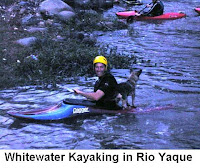
Our five newest students got an extra special taste of Costa Rican culture on Christmas Day when Doña Carmen – one of our cooks and all-around Base Angels – invited everyone into her home for a holiday meal.
Shortly after getting to our base and completing their “Duffle Shuffle,” the participants in our Adult Reconnect with Nature course (Dec 26, 2009 – Jan 3, 2010) joined their instructor, Santiago Lopez, and a handful of Outward Bound staffers in a trek up the hill from our Base to Doña Carmen’s house.
Upon arrival, glasses were filled with juice, eggnog and wine (this is an Adult course, after all!) and plates while piled high with well-seasoned fish, pan-fried chicken and vegetables, fresh salad and two of Costa Rica’s finest staples: rice and beans. And at least one bottle of Lizano sauce was emptied before the evening was through.
The similarities between how North Americans and Ticos celebrate Christmas were immediately apparently. Most Ticos decorate a tree (often a fragrant cypress tree) with ornaments and a gold star on top – and Doña Carmen’s family was no exception sporting a lovely and well-lit tree in the front room of their home.
The Nativity Scene (known as “El Portal) is of particular importance. These are decorated constructed of mosses and grass, colored sawdust, cypress twigs, black paper, silver glitter and figurines representing the birth of Jesus in the manger. Along with the traditional figures of Mary, Joseph, Baby Jesus, shepherds, the three wise men and the ox and mule, Costa Ricans commonly add extra embellishments like dolls, little farm animals, tiny toys, fruits and berries, and lights.
Most importantly, Christmas in Costa Rica – as it is all over the world – is a time to be spent with family and friends.
As most of the students had never been to Costa Rica before – the joyous surprise of a home-cooked meal made for the perfect introduction to the famous Tico hospitality – as well as a perfect start to their nine-day adventure.
The Adult Reconnect with Nature course – for people 21 and up – combines all of the elements of our popular summertime Multi-Element Courses. It gives participants a chance to trek through the rain and cloud forest on their way to Piedras Blancas where they experience several nights’ homestay in a remote, rural village. Following the hiking phase of the course come a collage of water activities including surfing some of the west coasts’ best beaches and whitewater rafting on world-class rivers.
The students in our current holiday course range in age from 26 to 53 and hail from both the United States and Canada.







































